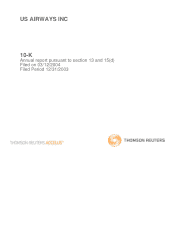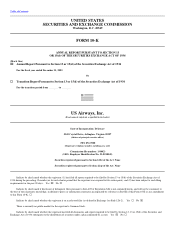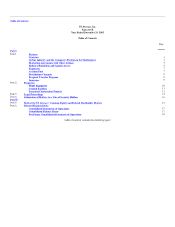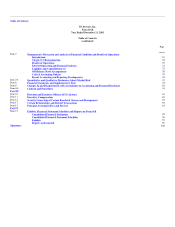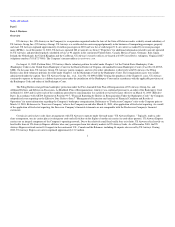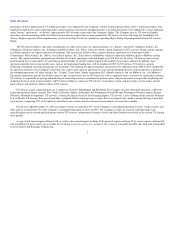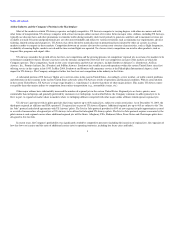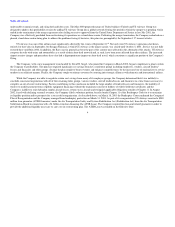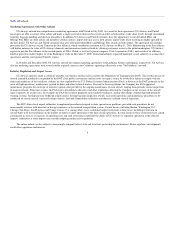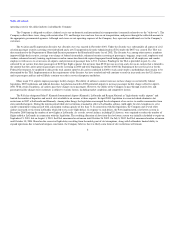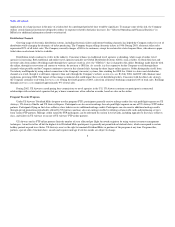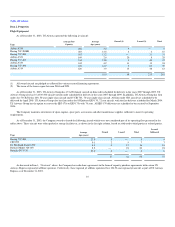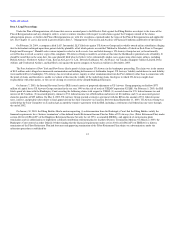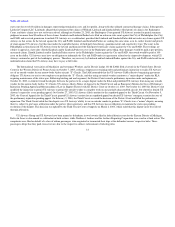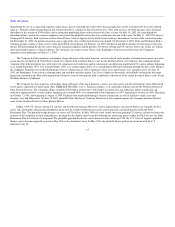US Airways 2003 Annual Report Download - page 10
Download and view the complete annual report
Please find page 10 of the 2003 US Airways annual report below. You can navigate through the pages in the report by either clicking on the pages listed below, or by using the keyword search tool below to find specific information within the annual report.
Table of Contents
Marketing Agreements with Other Airlines
US Airways entered into comprehensive marketing agreements with United in July 2002. As a result of these agreements, US Airways and United
passengers are able to contact either airline and make a single reservation that involves travel on either or both airlines (code share travel) through streamlined
ticketing, baggage handling and check-in procedures. In addition, US Airways and United customers have the opportunity to earn Dividend Miles and
Mileage Plus Miles on either airline and members of either airlines' airport club may access both airlines' airport clubs when traveling on flights operated by
the host airline. US Airways and United customers may also redeem Dividend Miles and Mileage Plus awards on both airlines. The agreement also includes
provisions for US Airways to join United in the Star Alliance, which extended an invitation to US Airways on May 31, 2003. Membership in the Star Alliance
will further enhance the value of US Airways' domestic and international route network by allowing customers access to the global marketplace. US Airways
expects to join the Star Alliance in the second quarter of 2004. United, as well as its parent company, UAL Corporation (UAL), and certain of its affiliates,
filed for protection under Chapter 11 of the Bankruptcy Code on December 9, 2002. United immediately requested bankruptcy court authority to assume these
agreements and the court granted United's request.
In October and December 2003, US Airways entered into similar marketing agreements with Lufthansa Airlines and Spanair, respectively. US Airways
also has marketing agreements with several smaller regional carriers in the Caribbean, operating collectively as the "GoCaribbean" network.
Industry Regulation and Airport Access
US Airways operates under a certificate of public convenience and necessity issued by the Department of Transportation (DOT). This certificate may be
altered, amended, modified or suspended by the DOT if the public convenience and necessity so require, or may be revoked for failure to comply with the
terms and conditions of the certificate. Airlines are also regulated by the U.S. Federal Aviation Administration (FAA), a division of the DOT, primarily in the
areas of flight operations, maintenance, ground facilities and other technical matters. Pursuant to these regulations, the Company has FAA-approved
maintenance programs for each type of aircraft it operates that provide for the ongoing maintenance of such aircraft, ranging from periodic routine inspections
to major overhauls. From time-to-time, the FAA issues airworthiness directives and other regulations affecting the Company or one or more of the aircraft
types it operates. In recent years, for example, the FAA has issued or proposed such mandates relating to, among other things, enhanced ground proximity
warning systems; fuselage pressure bulkhead reinforcement; fuselage lap joint inspection rework; increased inspections and maintenance procedures to be
conducted on certain aircraft; increased cockpit security; fuel tank flammability reductions and domestic reduced vertical separation.
The DOT allows local airport authorities to implement procedures designed to abate special noise problems, provided such procedures do not
unreasonably interfere with interstate or foreign commerce or the national transportation system. Certain locales, including Boston, Washington, D.C.,
Chicago, San Diego, San Francisco and Orange County, CA, among others, have established airport restrictions to limit noise, including restrictions on
aircraft types to be used and limits on the number of hourly or daily operations or the time of such operations. In some instances these restrictions have caused
curtailments in services or increases in operating costs and such restrictions could limit the ability of US Airways to expand its operations at the affected
airports. Authorities at other airports may consider adopting similar noise regulations.
The airline industry is also subject to increasingly stringent federal, state and local laws protecting the environment. Future regulatory developments
could affect operations and increase
5

